This guide to Clean Eating Sweetener Options will help demystify healthier baking and dessert making. There are plenty of options to choose from, and some work better in some types of recipes than others.
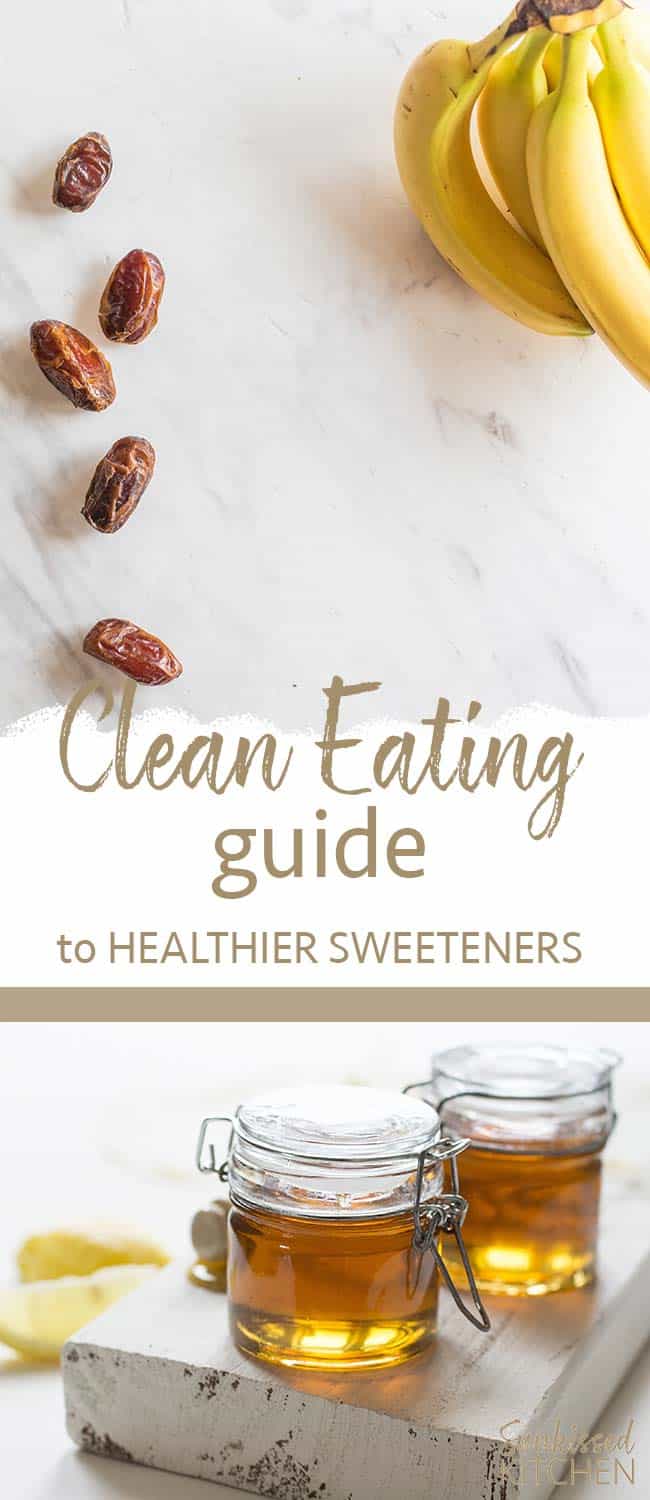
I love sweet treats, and a Clean Eating Lifestyle hasn’t stopped that.
I am all for eating for health, but you can’t eliminate all the foods you enjoy and stick to any sort of dietary lifestyle.
Food is more than just sustenance — and anyone who claims otherwise is living under a rock. Think about family traditions, holidays, your favorite memories as a child. So many of those are circled around food.
There are ways to make your favorite sweets and desserts using healthier ingredients (and using less sugar in general).
My dessert archives are proof! My healthy, lightly sweetened (or no sugar added) sweets and treats are the most popular recipes on my blog. Apparently, Chocolate Chip Mint is more exciting than 3-Bean Salads! (I think so, too).
Here are my favorite natural sweeteners, why they are a better option than table sugar, and how to use them!
Contents
1). Fruit!
I use fruit to sweeten the treats we have here at home the most often. Bananas, dates, mango, raisins and figs are all great sources of sugar, but they also come with the added bonus of fiber and loads of nutrients as well.
I use dates often. I love the caramelly sweetness, and they are just so versatile (and very sweet!). I use them for my ever-popular Oatmeal Walnut Date Bars (so so good), and I also puree them and use them in muffins and cakes.
Dates are high in sugar (66%), but that’s what makes them a great substitute for the processed stuff. In addition to all that sweetness, you’re also getting a boost of calcium, iron, vitamin K and B vitamins.
Bananas are also a really popular choice over here. We love them frozen — and most often, I just chop the frozen bananas and use them to sweeten plain yogurt (makes it ice-cream like!), but we also process the frozen bananas into “nice cream,” a soft-serve consistency treat. There’s all sorts of variations to this- right now we are loving bananas, mango, and dragon fruit together (see below).
We also use bananas in baked goods. Mashing bananas into quick breads and muffins allows for less added sweetener, and you can even make cookies using no sugar at all, relying on the sweetness of the fruit.
Recipes to Try Using Only Fruit to Sweeten:
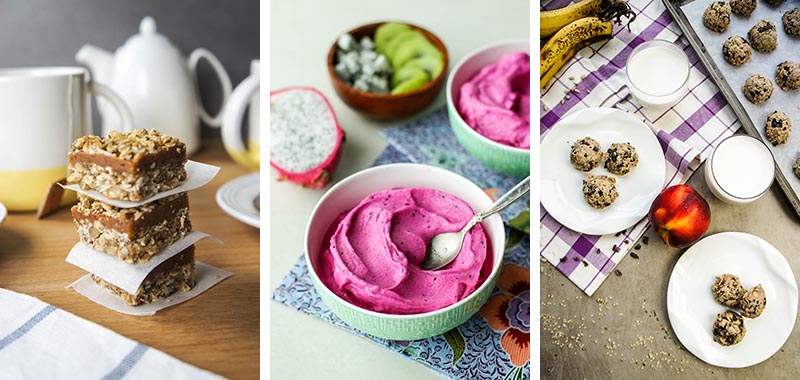
- Oatmeal Walnut Date Bars
- Dragon Fruit Smoothie Bowls (or “Nice Cream”)
- Chocolate Cherry Breakfast Cookies
2). Date Syrup

The only problem? Adding a date to your nut milks (or your coffee drinks) really clogs up the nut milk bag/strainer, and it does take time and gets a bit messy. I do it anyway. Anyone who makes their own yogurt isn’t going to be scared away by a little date puree.
Date syrup doesn’t have all the health-boosting fiber in the whole fruit, but it does benefit from being similarly nutrient-dense.
Date syrup is a great sub for honey or maple syrup in baked goods, especially if you like less-sweet options, since it’s not quite as sweet as either.
Recipes to Try with Date Syrup: (I don’t currently have recipes posted using date syrup, but you can use it as a sub for the whole dates in these recipes)
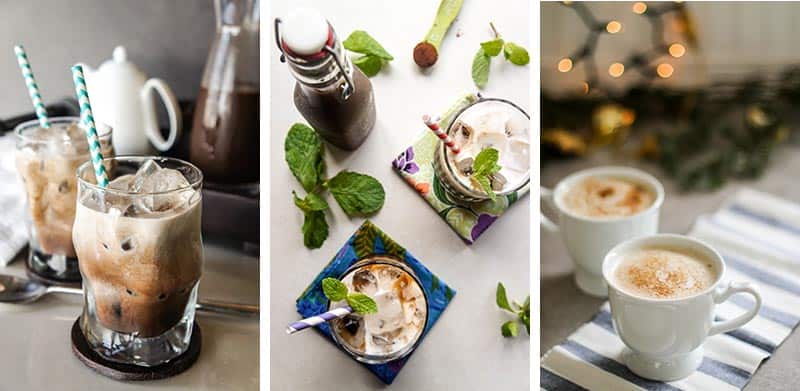
3). Honey
Honey is another sweetener I love 
The calories and sugar content of honey is similar to table sugar– so why bother use this option? Honey is a natural antiseptic, meaning it has anti-bacterial, anti-viral, and anti-fungal properties. In short, it will help keep you healthier.
It also has a higher nutrient content than plain sugar – so while it’s far from being a superfood, you do benefit from trace amounts of calcium, iron, potassium, B vitamins, and more.
Plus, honey (55) has a lower glycemic index than sugar (68), meaning the sugar is more slowly released into your blood stream, helping to reduce sugar crashes or large fluctuations in your blood sugar level.
Recipes to Try with Honey:
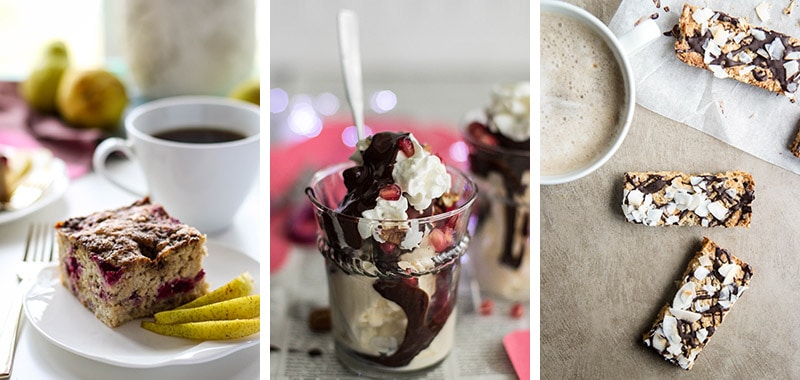
4). Coconut Sugar
I’ve completely fallen in love with coconut sugar. It has such a wonderfully warm and toasty flavor, so it lends a caramelly flavor to your baked goods as well as adding sweetness. Perfect for streusel toppings!
The biggest reason for making the switch to coconut sugar is the crazy low glycemic index- 35! (Remember honey is 55 and white sugar is 68). It’s the perfect sweetener to use if you’re baking for kids – they’ll love it, and no sugar crashes!
Making coconut sugar is a natural process, requiring no chemicals or processes that might degrade its nutrients. Sap is collected from coconut palm flowers, and then the sap is heated until the water has evaporated.
Sugar cane is known to be grown using lots of pesticides and chemicals, and to make it worse, in processing sugar, the nutrients are stripped, and the remaining sugar crystals are purified to a glittering white using chemicals.
I’ll take my sugar with the associated nutrients in tact, please.
Recipes to Try with Coconut Sugar:
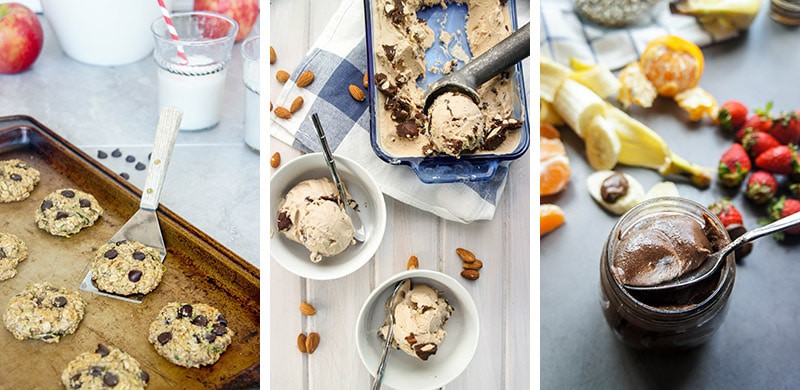
- Zucchini Chocolate Chip Oatmeal Cookies
- Mocha Fudge Almond Greek Frozen Yogurt
- Chocolate Sunflower Butter (move over, Nutella!)
5). Blackstrap Molasses

So while molasses is still a product of cane sugar, it’s the best part! It has all the flavor, plus B6, maganese, magnesium, iron, potassium, and selenium. It’s glycemic index is 55, the same as honey.
Molasses is what gives gingerbread its rich, dark flavor, and I use it in similar recipes.
Recipes to Try with Blackstrap Molasses:
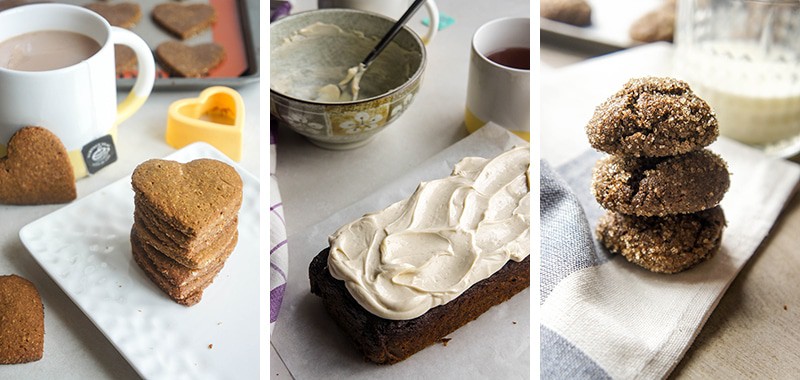
Other Alternative Sweeteners:


Artificial/Non-Caloric Sweeteners:
Often, healthier recipes are sweetened with non-caloric sweeteners, which I was drawn to when I first began this clean eating journey.


The ones to stay away from are the ones made in a lab (chemical sweeteners). These are acesulfame potassium, aspartame, neotame, saccharin, sucralose, xylitol and sorbitol. Their brands names are Equal, NutraSweet, NatraTaste Blue, Splenda, ACE K, Sunette, Equal Spoonful, Sweet One, Sweet ‘n Safe, Sweet ‘n Low, and Sweet Twin). You can read more about these chemical sweeteners and why you should avoid them in my article, Food Additives to Avoid + A Clean Eating Kitchen Sweep.



Important information, and I totally agree with you about the artificial sweeteners – they are dreadful! My mother is always pushing blackstrap molasses on me as its high in iron.
Your mother is smart! I love blackstrap– such great flavor. Except I don’t use it often just because it’s too dark and doesn’t make nice colored baked goods to photograph 🙂
Love this! I always add bananas to my french toast and pancake batters to make it naturally sweet so we use less or no maple syrup. Also a big fan of dates and dates sugar!
Great information. I’ve a few of these often, but definitely need to try your other tips
Such a great guide! Dates are a new favorite of mine. Definitely a great way to continue to enjoy sweets while getting some nutrition too.
I agree Tara! I hated the look of dates for so long, and once I tried them, I was hooked!
I use all the sweeteners you mentioned! Great list!
Great tips on how to sweeten food without sugar! I usually use honey but will try some of the other options that you mentioned.
Honey is certainly my go-to– but lately I’ve been using whole dates more and more, and have found that I actually prefer the lightness of date syrup to honey a lot of the time.
Always naturally sweet (fruit) or pure stevia for me!
What a fantastic resource, I know sooo many people who get a lot of use out of this!
edit: so many people who *will get a lot of use out of this. 😉 Oi.